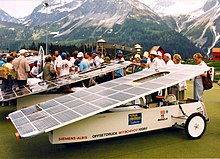
Auto racing is a motorsport involving the racing of automobiles for competition.

The Dakar Rally is an annual rally raid organised by the Amaury Sport Organisation. Most events since the inception in 1978 were staged from Paris, France, to Dakar, Senegal, but due to security threats in Mauritania, which led to the cancellation of the 2008 rally, events from 2009 to 2019 were held in South America. Since 2020, the rally has been held in Saudi Arabia. The event is open to amateur and professional entries, professionals typically making up about eighty percent of the participants.
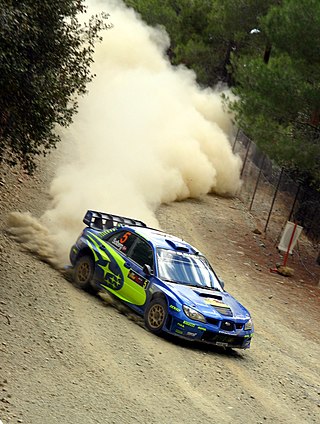
Rally is a wide-ranging form of motorsport with various competitive motoring elements such as speed tests, navigation tests, or the ability to reach waypoints or a destination at a prescribed time or average speed. Rallies may be short in the form of trials at a single venue, or several thousand miles long in an extreme endurance rally.
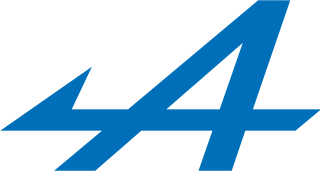
The Société des Automobiles Alpine SAS, commonly known as Alpine, is a French manufacturer of racing and sports cars established in 1955. The Alpine car marque was created in 1954.

The World Rally Championship is the highest level of global competition in the motorsport discipline of rallying, owned and governed by the FIA. There are separate championships for drivers, co-drivers, manufacturers and teams. The series currently consists of 13 three to four-day rally events driven on surfaces ranging from gravel and tarmac to snow and ice. Each rally is usually split into 15–25 special stages which are run against the clock on up to 350 kilometres of closed roads.

Motorsport, motorsports or autosports is a global term used to encompass the group of competitive sporting events which primarily involve the use of motorized vehicles. The terminology can also be used to describe forms of competition of two-wheeled motorised vehicles under the banner of motorcycle racing, and includes off-road racing such as motocross.

The World Solar Challenge (WSC), since 2013 named Bridgestone World Solar Challenge, is an international event for solar powered cars driving 3000 kilometres through the Australian outback.

A switcher or shunter, is a type of small locomotive used for maneuvering railway vehicles over short distances. Switchers do not usually move trains over long distances, instead they typically assemble trains in order for another locomotive to take over. Switchers often operate in a railyard or make short transfer runs. They may serve as the primary motive power on short branch lines or switching and terminal railroads.
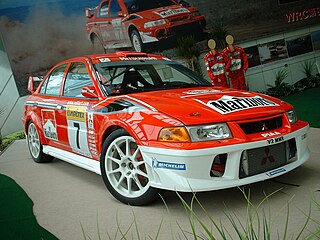
Group A is a set of motorsport regulations administered by the FIA covering production derived vehicles intended for competition, usually in touring car racing and rallying. In contrast to the short-lived Group B and Group C, Group A vehicles were limited in terms of power, weight, allowed technology and overall cost. Group A was aimed at ensuring numerous entries in races of privately owned vehicles.

A solar vehicle or solar electric vehicle is an electric vehicle powered completely or significantly by direct solar energy. Usually, photovoltaic (PV) cells contained in solar panels convert the sun's energy directly into electric energy. The term "solar vehicle" usually implies that solar energy is used to power all or part of a vehicle's propulsion. Solar power may be also used to provide power for communications or controls or other auxiliary functions.

Romanshorn is a municipality in the district of Arbon in the canton of Thurgau in Switzerland.
The International Sporting Code (ISC) is a set of rules which are valid for all auto racing events that are governed by the Fédération Internationale de l'Automobile (FIA). North American domestic racing, such as NASCAR and IndyCar are outside the FIA's jurisdiction and hence not governed by the ISC. Motorcycle sport is also exempt since the Fédération Internationale de Motocyclisme (FIM) is responsible for this sport, not the FIA.
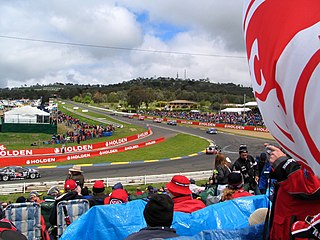
Motorsport is a popular spectator sport in Australia, although there are relatively few competitors compared to other sports due to the high costs of competing. The oldest motorsport competition in Australia is the Alpine Rally which was first staged in 1921 followed by the Australian Grand Prix, first staged in 1928. The most widely watched motorsport category is Supercars, especially at the Bathurst 1000. Other classes in Australia include Australian GT, Formula 3 and Formula Ford, Superbikes, as well as various forms of speedway racing.

A solar car is a solar vehicle for use on public roads or race tracks. Solar vehicles are electric vehicles that use self-contained solar cells to power themselves fully or partially from sunlight. Solar vehicles typically contain a rechargeable battery to help regulate and store the energy from the solar cells and from regenerative braking. Some solar cars can be plugged into external power sources to supplement the power of sunlight used to charge their battery.
Solar car racing refers to competitive races of electric vehicles which are powered by solar energy obtained from solar panels on the surface of the car. The first solar car race was the Tour de Sol in 1985 which led to several similar races in Europe, US and Australia. Such challenges are often entered by universities to develop their students' engineering and technological skills, but many business corporations have entered competitions in the past. A small number of high school teams participate in solar car races designed exclusively for high school students.

The Voralpen-Express (VAE) is a named train connecting small to medium-sized cities and villages in Central and Eastern Switzerland, carrying this name since 1992. It is operated by Südostbahn (SOB) and runs every hour between St. Gallen and Lucerne, bypassing Zurich. Its name derives from the fact that it traverses the Prealps.

TT Zero – an electric motorsport event introduced for the 2010 Isle of Man TT races – replaced the similar TTXGP race as a 1-lap circuit of the Snaefell Mountain Course. The TT Zero event as an officially sanctioned Isle of Man TT race is for racing motorcycles where "The technical concept is for motorcycles to be powered without the use of carbon based fuels and have zero toxic/noxious emissions." The Isle of Man Government offered a prize of £10,000 for the first entrant to exceed the prestigious 100 mph average speed around the Mountain Course.
The German Solar Mobility Association / German Bundesverband Solare Mobilität is an interest group in Germany to further electric mobility in combination of regenerative resources for the required electricity. The BSM is the provider of the Park & Charge network in Germany. The BSM is member of a number of committees of the German government including the National Electric Mobility Platform.

Stella and its successors Stella Lux, Stella Vie and Stella Era are a series of solar racing family cars, built for the World Solar Challenge in Australia, sofar winning its Cruiser Class all four times it was held – in 2013, 2015, 2017 and in 2019. Stella is considered the world’s first solar-powered family car and was given the 'Best Technology Development' Award at the 8th annual Crunchies in San Francisco in 2015. Being the only competing vehicle with a license plate, the road registration of Stella contributed to the winning score in the races. The vehicles are designed and built by "Solar Team Eindhoven" (STE) — some 26 students of different faculties of the Eindhoven University of Technology (TU/e) in the Netherlands. The group have set up a non-profit foundation to promote their concepts for practical solar vehicles for adoption on a broader scale.
